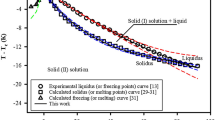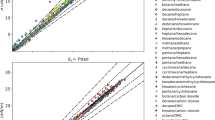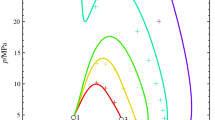Abstract
The Kirkwood–Buff (K-B) integrals play an important role in characterizing the intermolecular interactions in liquid mixtures. The interaction is represented by the K-B parameters, G AA,G BB, and G AB, which reflect correlation between like-like and like-unlike species in the mixture. The K-B integrals of binary mixtures of tetrahydrofuran with benzene, toluene, o-xylene, m-xylene, p-xylene and mesitylene at 298.15 K and atmospheric pressure have been computed from the experimental data of ultrasonic speed and density. We have used the similar inverse procedure (as proposed by Ben-Naim) to compute the K-B parameters of the mixture, in which thermodynamic information on mixtures, such as partial molar volumes, isothermal compressibility and experimental data of partial vapor pressures were used. A new route has been incorporated by using regular solution theory in the computation of excess Gibbs energy for obtaining the partial vapor pressures of binary liquid mixtures. The low values of excess entropy, S E≈0, obtained for these mixtures indicate the applicability of regular solution theory to the mixtures. The values of the K-B parameter, G AB, obtained using this procedure indicate that the correlation/affinity between THF and aromatic hydrocarbon molecules follows the order: benzene > toluene > o-xylene > m-xylene > p-xylene > mesitylene, which is in good agreement with the results obtained from the trends exhibited by the excess functions of these mixtures.
Similar content being viewed by others
References
Iloukhani, H., Zoorasna, Z., Soleimani, R.: Excess molar volumes and speeds of sound of tetrahydrofuran with chloroethanes or chloroethenes at 298.15 K. Phys. Chem. Liq. 43, 391–401 (2005)
George, J., Sastry, N.V.: Partial excess molar volumes, partial excess isentropic compressibilities and relative permittivities of water + ethane-1,2-diol derivative and water + 1,2-dimethoxy ethane at different temperatures. Fluid Phase Equilib. 216, 307–321 (2004)
Giner, B., Artigas, H., Carrion, A., Lafuente, C., Royo, F.M.: Excess thermodynamic properties of isomeric butanols with 2-methyltetrahydrofuran. J. Mol. Liq. 108, 303–311 (2003)
Nain, A.K.: Ultrasonic and viscometric studies of molecular interactions in binary mixtures of acetonitrile with some amides at different temperatures. Bull. Chem. Soc. Jpn. 79, 1688–1695 (2006)
Nain, A.K.: Densities and volumetric properties of (formamide + ethanol, or 1-propanol, or 1,2-ethanediol, or 1,2-propanediol) mixtures at temperatures between 293.15 and 318.15 K. J. Chem. Thermodyn. 39, 462–473 (2007)
Nain, A.K.: Ultrasonic and viscometric studies of molecular interactions in binary mixtures of formamide with ethanol, 1-propanol, 1,2-ethanediol and 1,2-propanediol at different temperatures. J. Mol. Liq. 140, 108–116 (2008)
Nain, A.K.: Densities and volumetric properties of binary mixtures of formamide with 1-butanol, 2-butanol, 1,3-butanediol and 1,4-butanediol at temperatures between 293.15 and 318.15 K. J. Solution Chem. 36, 497–516 (2007)
Nain, A.K.: Molecular interactions in binary mixtures of formamide with 1-butanol, 2-butanol, 1,3-butanediol and 1,4-butanediol at different temperatures: An ultrasonic and viscometric study. Fluid Phase Equilib. 265, 46–56 (2008)
Ali, A., Nain, A.K., Chand, D., Ahmad, R.: Volumetric and ultrasonic studies of molecular interactions in binary mixtures of dimethyl sulfoxide with some aromatic hydrocarbons at different temperatures. Bull. Chem. Soc. Jpn. 79, 702–710 (2006)
Ali, A., Nain, A.K.: Ultrasonic and volumetric study of binary mixtures of benzyl alcohol with amides. Bull. Chem. Soc. Jpn. 75, 681–687 (2002)
Kirkwood, J.G., Buff, F.P.: The statistical mechanical theory of solutions. J. Chem. Phys. 19, 774–777 (1951)
Ben-Naim, A.: Inversion of Kirkwood–Buff theory of solutions: Application to the water-ethanol system. J. Chem. Phys. 67, 4884–4890 (1977)
Shuglin, I.L., Ruckenstein, E.: The Kirkwood–Buff theory of solutions and the local composition of liquid mixtures. J. Phys. Chem. B 110, 12707–12713 (2006)
Perera, A., Sokolic, F., Almasy, L., Koga, Y.: Kirkwood–Buff integrals of aqueous alcohol binary mixtures. J. Chem. Phys. 124, 124575-1–124575-9 (2006)
Gonzalez, J.A., Mozo, I., Villa, S., Riesco, N., De La Fuente, I.G., Cobos, J.C.: Thermodynamics of mixtures containing organic carbonates. Part XV. Application of the Kirkwood–Buff theory to the study of interactions in liquid mixtures containing dialkyl carbonates and alkanes, benzene, CCl4 or 1-alkanols. J. Solution Chem. 35, 787–801 (2006)
Donkersloot, M.C.A.: The structure of binary liquids. The Kirkwood-Buff theory of liquid mixtures, illustrated on the basis of systemswater/methanol, water/ethanol, and cyclohexane/2,3-dimethylbutane, as a link between thermmodynaimc data and X-ray and neutron scattering results. J. Solution Chem. 8, 293–307 (1979)
Newman, K.E.: Kirkwood–Buff solution theory: Derivation and application. Chem. Soc. Rev. 23, 31–40 (1994)
Newman, K.E.: Application of Kirkwood–Buff theory to enthalpies of transfer and expansibilities of solutes in binary solvent mixtures. J. Chem. Soc. Faraday Trans. 84, 3885–3890 (1988)
Vergara, A., Paduano, L., Capuano, F., Sartorio, R.: Kirkwood–Buff integrals for polymer-solvent mixtures. Preferential solvation and volumetric analysis in aqueous PEG solutions. Phys. Chem. Chem. Phys. 4, 4716–4723 (2002)
Zielkiewicz, J.: Solvation of amide group by water and alcohols investigated using the Kirkwood–Buff theory of solutions. J. Chem. Soc. Faraday Trans. 94, 1713–1719 (1998)
Banerjee, D., Laha, A.K., Chatterjee, P., Bagchi, S.: Preferential solvation in three component systems: Evaluation of Kirkwood–Buff parameters. J. Solution Chem. 24, 301–310 (1995)
Covington, A.K., Newman, K.E.: Application of Kirkwood–Buff theory to free energies of transfer of electrolytes from one solvent to other. J. Chem. Soc. Faraday Trans. 84, 1393–1404 (1988)
Pandey, J.D., Verma, R.: Inversion of Kirkwood–Buff theory of solutions: application to binary systems. Chem. Phys. 270, 429–438 (2001)
Guha, A., Ghosh, N.K.: Partial molar quantities and thermodynamic interaction parameters for some binary mixtures: CH2Cl2 + CS2, CH3OH + CCl4, CH3OH + C6H6 and CH3OH + CHCl3 systems. Indian J. Chem. 45A, 593–598 (2006)
Matteoli, E.: A study on Kirkwood–Buff integrals and preferential solvation in mixtures with small deviation in ideality and/or with size mismatch of components. Importance of a proper reference system. J. Phys. Chem. B 101, 9800–9810 (1997)
Marcus, Y.: Preferential solvation in mixed solvents. J. Solution Chem. 35, 251–277 (2006)
Nain, A.K.: Densities and volumetric properties of binary mixtures of tetrahydrofuran with some aromatic hydrocarbons at temperatures from 278.15 to 318.15 K. J. Solution Chem. 35, 1417–1439 (2006)
Nain, A.K.: Ultrasonic and viscometric studies of molecular interactions in binary mixtures of tetrahydrofuran with some aromatic hydrocarbons at temperatures between 288.15 and 318.15. Phys. Chem. Liq. 45, 371–388 (2007)
Nain, A.K.: Densities and volumetric properties of (acetonitrile + an amide) at temperatures between 293.15 and 318.15 K. J. Chem. Thermodyn. 38, 1362–1370 (2006)
Hildebrand, J.H., Scott, R.L.: Regular Solutions. Prentice Hall, Englewood Cliffs (1962)
Hildebrand, J.H.: The entropy of solution of molecules of different size. J. Chem. Phys. 15, 225–228 (1947)
Dack, M.R.J.: The importance of solvent internal pressure and cohesion to solution phenomena. Chem. Soc. Rev. 4, 211–229 (1975)
Pal, A., Kumar, H.: Prediction of excess heat capacity from internal pressure data for n-alkoxyethnol + water mixtures at 298.15 K. Indian J. Chem. 43A, 28–34 (2004)
Patterson, D.: Structure and thermodynamics of non-electrolyte mixtures. J. Solution Chem. 23, 105–120 (1994)
Author information
Authors and Affiliations
Corresponding author
Rights and permissions
About this article
Cite this article
Nain, A.K. Inversion of the Kirkwood–Buff Theory of Solutions: Application to Tetrahydrofuran + Aromatic Hydrocarbon Binary Liquid Mixtures. J Solution Chem 37, 1541–1559 (2008). https://doi.org/10.1007/s10953-008-9326-7
Received:
Accepted:
Published:
Issue Date:
DOI: https://doi.org/10.1007/s10953-008-9326-7




